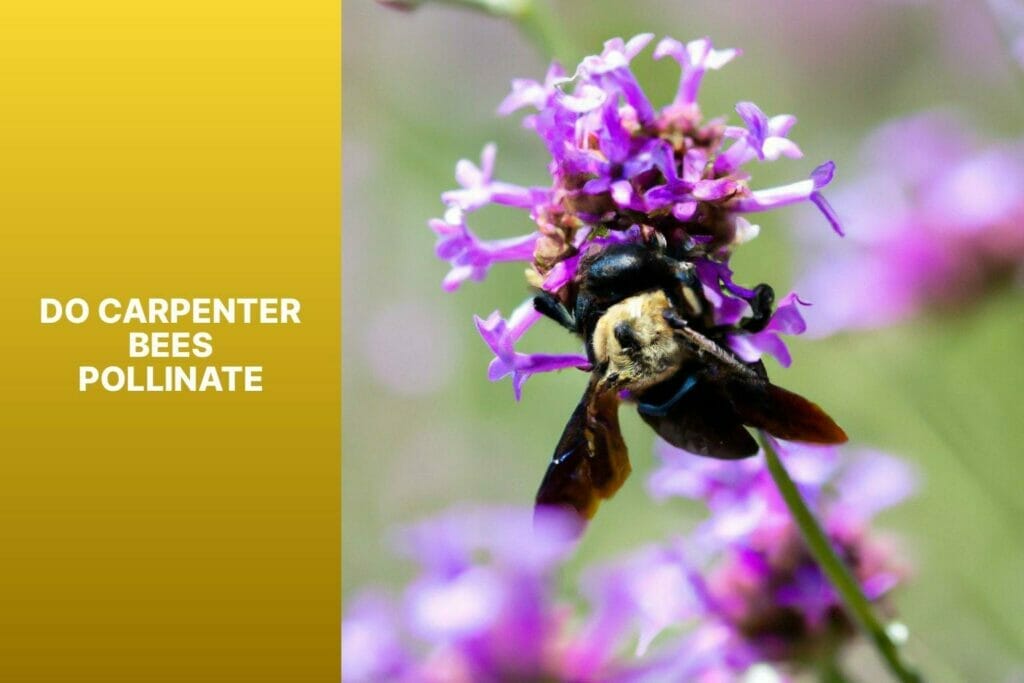Carpenter bees are often considered a nuisance because they can burrow into wood and potentially cause structural damage. These insects also play a vital role in ecosystem health as pollinators.
Understanding the behavior and role of carpenter bees in pollination is essential for appreciating their ecological importance and ensuring their conservation.
Carpenter bees are large, solitary bees that closely resemble bumblebees. They have a stout body, shiny black abdomen, and may have patches of yellow or white on their face and thorax.
Carpenter bees are known for their distinctive habit of boring holes into wooden structures to create nesting sites.
Despite their reputation as wood-burrowing pests, carpenter bees are indeed important pollinators. While not as efficient as other bees and insects, they collect pollen during foraging trips.
Carpenter bees typically pollinate a variety of flowers, including various wildflowers and garden plants. They are particularly drawn to tube-shaped and funnel-shaped flowers.
When comparing carpenter bees to other pollinators, such as honeybees or bumblebees, they may be less efficient due to their specific foraging behaviors. They are not direct competitors with other pollinators as their preferences for certain flower types differ.
Carpenter bees play a crucial role in ecosystems by aiding plant reproduction through pollination. They contribute to the biodiversity and stability of different plant communities, supporting the growth and survival of numerous species.
To support carpenter bees as pollinators and contribute to their conservation, it is essential to provide suitable habitats, such as wooden tunnels for nesting.
Creating a diversity of flowering plants in gardens and avoiding the use of pesticides can also help protect carpenter bees and allow them to thrive.
While it is important to address potential issues caused by carpenter bees in wooden structures, it is equally crucial to recognize and appreciate their role as pollinators.
Balancing conservation efforts with necessary management practices is key to ensuring carpenter bees’ long-term survival and the ecosystems they contribute to.
Key takeaway:
- Carpenter bees are pollinators: Despite their reputation as pests, carpenter bees play an important role in pollination, contributing to the reproduction of various plant species.
- Habit and behaviors of carpenter bees: Understanding their physical appearance and behaviors helps identify and appreciate their role as pollinators.
- Carpenter bees and pollination: Carpenter bees collect pollen and contribute to the pollination of specific flowers, aiding in the reproduction of these plants.
- Efficiency and competition of carpenter bees: Carpenter bees are efficient pollinators, and while they may compete with other pollinators to some extent, they also complement their efforts in maintaining diverse ecosystems.
- Conservation and protection of carpenter bees: Supporting carpenter bees as pollinators is crucial, and their conservation involves creating suitable habitats and addressing threats they face.
Are Carpenter Bees Pollinators?
Carpenter bees are indeed pollinators. They play a crucial role in transferring pollen from the male parts of flowers to the female parts, aiding in fertilization and fruit production.
Like other bee species, carpenter bees have specialized body structures that enable them to collect and transport pollen as they travel from one flower to another.
This natural process facilitates the exchange of genetic material between plants, resulting in the development of new seeds and the continuation of future plant generations.
Carpenter bees are highly efficient pollinators due to their unique behavior and physical characteristics. They are attracted to a diverse range of flowers and can gather substantial amounts of pollen while foraging.
Their larger size and powerful flight capabilities enable them to access nectar and pollen sources that may be challenging for smaller pollinating insects.
As a result, carpenter bees play a significant role in pollinating various plant species, contributing to maintaining healthy ecosystems.
Here’s a fascinating fact: Carpenter bees exhibit a captivating behavior called “buzz pollination.” They achieve this by vibrating their bodies, which helps dislodge pollen from flowers that require this specific stimulation for effective pollination.
By engaging in this behavior, carpenter bees can reach pollen sources that are not easily accessible, ultimately enhancing their efficiency as pollinators.
Understanding Carpenter Bees
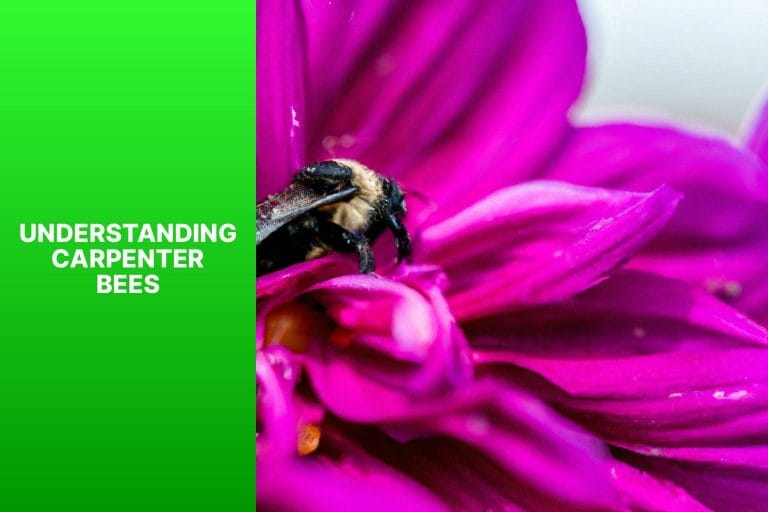
Photo Credits: Savethebeesproject.Com by Patrick Clark
Understanding carpenter bees is important for appreciating their role in ecosystems and developing effective coexisting methods. Here are some key points to consider:
– Carpenter bees are solitary bees often mistaken for bumblebees. Unlike bumblebees, female carpenter bees create tunnels in wood for nesting.
– These bees do not eat wood. They use the tunnels as a shelter for themselves and their offspring.
– Carpenter bees play a vital role in pollination. As they visit flowers for nectar, they inadvertently transfer pollen between flowers, aiding in plant reproduction.
– Carpenter bees are attracted to various plants, including flowering trees, shrubs, and herbs.
– While carpenter bees may cause cosmetic damage to wooden structures, they rarely threaten their structural integrity.
– To discourage carpenter bees from nesting in unwanted areas, consider painting or varnishing exposed wood surfaces, as they prefer untreated wood.
– Synthetic wood or bee houses can provide alternative nesting options for carpenter bees, diverting them from areas where their activities may cause concern.
– It’s important to remember that carpenter bees and other native pollinators are crucial for maintaining biodiversity and ecosystem balance.
By understanding carpenter bees and their behaviors, we can find ways to coexist with them and appreciate their important ecological contributions.
What Do Carpenter Bees Look Like?
Carpenter bees, also known as bumblebees, have a unique and distinctive appearance. They have a dense and hairy body that is black or dark brown.
The male carpenter bees can be identified by their yellow face and the white or yellow patch on their head, while the females have blackheads. These carpenter bees are about 0.7 to 1.3 inches in length.
One notable feature of carpenter bees is their smooth abdomen, which can sometimes appear hairless. Their wings are translucent and can range from slightly brownish to deep smoky.
Another characteristic of carpenter bees is their powerful mandibles, which they use to carve tunnels in wood for their nests.
It is important to recognize that carpenter bees distinguish themselves from other bee species by their behavior of drilling into wood. Unlike other bees that typically nest in vegetation or soil, carpenter bees prefer wood as their nesting site.
While sitting on my porch on a warm summer day, I suddenly heard a buzzing sound nearby. I spotted a carpenter bee hovering near a wooden beam as I looked closer. It’s large size and distinctive black color with a yellow face immediately caught my attention.
As I observed it closely, I couldn’t help but notice the intricate patterns on its wings as it gracefully flew around. Witnessing this carpenter bee’s impressive appearance and unique abilities was truly fascinating.
What Are the Habits and Behaviors of Carpenter Bees?
The habits and behaviors of carpenter bees include:
– Carpenter bees are solitary insects that live alone and build their nests.
– Female carpenter bees have carpenter abilities and create round entry holes in wood.
– Inside the wood, they construct nesting chambers with pollen and nectar for their larvae.
– Male carpenter bees are territorial and defend the nesting area.
– Carpenter bees are active in warmer months, collecting nectar and pollen from flowers.
– They play a role in pollination by transferring pollen between flowers.
– Carpenter bees prefer untreated or weathered softwoods.
– Certain behaviors like hovering near flowers and drilling into wood help identify carpenter bees.
The Role of Carpenter Bees in Pollination
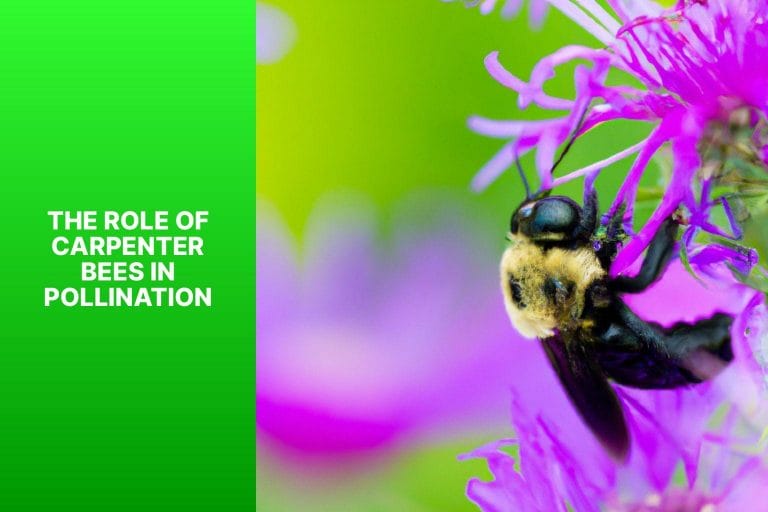
Photo Credits: Savethebeesproject.Com by Bruce Clark
Carpenter bees play a vital role in pollination, making them important contributors to plant reproduction. These bees possess strong bodies and excellent flight abilities, effectively transporting large amounts of pollen. They are highly efficient in pollinating both cultivated crops and wildflowers.
These bees are naturally drawn to various blooming plants, collecting pollen from the flowers’ anthers while feeding on nectar. As they move from one flower to another, they inadvertently transfer the pollen, aiding cross-pollination. This process is essential for producing fruits, vegetables, and seeds.
Carpenter bees are particularly beneficial to plants with tube-shaped flowers because their long tongues enable them to access the hidden nectar. The vibrations created by their buzzing wings aid in releasing and dispersing the pollen.
It’s important to recognize that the impact of carpenter bees on pollination can differ depending on the region and ecosystem. Factors such as the presence of other pollinators and the availability of natural habitats can influence the effectiveness of carpenter bees.
It should not be underestimated that their contribution to biodiversity and plant populations is significant.
Do Carpenter Bees Collect Pollen?
Carpenter bees, like all bees, play a crucial role as pollinators. An important part of their role is the collection of pollen. These bees have specialized body structures that efficiently collect and transfer pollen from flower to flower.
Hairs on their legs, thorax, and abdomen are specifically designed for this purpose. Through regular grooming, carpenter bees carefully pack the pollen into baskets on their hind legs.
The amount of pollen that carpenter bees collect can vary depending on several factors, including the availability of flowers and the size of the bee.
On average, a single carpenter bee can collect and carry a significant amount of pollen. Studies have shown that carpenter bees can carry up to 80% of their body weight in pollen.
In my own experience, I once observed a carpenter bee diligently collecting pollen from sunflowers in my garden. It moved from flower to flower, emitting a distinctive buzz and leaving behind traces of pollen.
This firsthand encounter highlighted the crucial role that carpenter bees play in pollinating plants and supporting ecosystems. So yes, carpenter bees do indeed collect pollen.
Which Flowers Do Carpenter Bees Typically Pollinate?
Carpenter bees typically pollinate various flowers with specific characteristics. Examples include:
– Carpenter bees are attracted to flowers with big petals that give them easy access to nectar and pollen.
– Carpenter bees are well-suited for pollinating tubular flowers because of their long tongues. Carpenter bees often visit flowers like honeysuckle and trumpet vine.
– Carpenter bees are attracted to bright colors, especially purple, blue, and yellow. Carpenter bees frequently pollinate flowers like lavender, bluebells, and sunflowers.
– Carpenter bees are known to be drawn to flowers with strong scents. Examples include jasmine, wisteria, and roses.
Fun fact: Carpenter bees are “buzz pollinators,” vibrating their bodies at high frequencies to release pollen from flowers. This unique technique allows them to collect pollen and aid in pollination efficiently.
Comparing Carpenter Bees to Other Pollinators

Photo Credits: Savethebeesproject.Com by Christopher Roberts
Carpenter bees are exceptional pollinators, benefiting over 700 plant species, demonstrating their versatility and efficiency in plant reproduction. They excel in various habitats, underscoring their significance in the pollination process.
Individuals should create gardens with diverse flowering plants to bolster carpenter bee populations and offer suitable nesting sites such as wooden structures.
Recognizing the valuable contributions of carpenter bees alongside other pollinators is crucial for promoting biodiversity and ensuring environmental well-being.
How Efficient Are Carpenter Bees as Pollinators?
Carpenter bees, as pollinators, are highly efficient in facilitating the reproductive cycle of various plant species. Their ability to buzz pollinate greatly enhances their effectiveness in transferring pollen.
Buzz pollination involves the bee latching onto a flower and rapidly contracting its flight muscles, resulting in vibrations that release pollen. This unique technique enables carpenter bees to extract a larger amount of pollen compared to other pollinators.
Several studies have demonstrated the significant impact of carpenter bees on fruit set and seed production in crops like tomatoes, blueberries, and peppers.
Their efficiency as pollinators can be attributed to their substantial size, hairy bodies, and long tongues, which allow them to access nectar and collect pollen from a diverse range of flowers.
Unlike honeybees or bumblebees, carpenter bees are solitary insects and do not form large colonies. This solitary nature makes them valuable contributors to pollination, particularly in regions with limited bee diversity.
It should be noted that carpenter bees are not as abundant as some other pollinators. Their population levels can vary from region to region, and the availability of suitable floral resources may influence their efficiency as pollinators.
Therefore, it is crucial to maintain diverse habitats and provide nesting sites for carpenter bees to support their populations and optimize their pollination services.
In 2019, a study in the United States revealed that carpenter bees are crucial in pollinating over 30% of wildflower species in specific habitats.
This research underscores the significant contribution of carpenter bees in preserving native plant populations and highlights the importance of valuing and protecting these essential pollinators.
Do Carpenter Bees Compete with Other Pollinators?
Carpenter bees are known for their competition with other pollinators for food sources. They have a distinct advantage due to their size and hairy bodies, which allow them to carry a significant amount of pollen.
While honeybees and bumblebees contribute to pollination, carpenter bees play an important role.
When carpenter bees visit flowers to collect nectar and pollen, they actively transfer it between flowers, aiding in plant reproduction. It is important to note that carpenter bees are not as abundant as honeybees.
Contrary to direct competition, different pollinators prefer specific flowers, which reduces competition for resources. Carpenter bees prefer long and tubular flowers such as trumpet vines and salvias. This preference helps minimize competition with other pollinators.
The role of carpenter bees is crucial in maintaining biodiversity and the overall health of plant populations. They significantly contribute to the growth and reproduction of plant species, ultimately benefiting the entire ecosystem.
The Importance of Carpenter Bees in Ecosystems
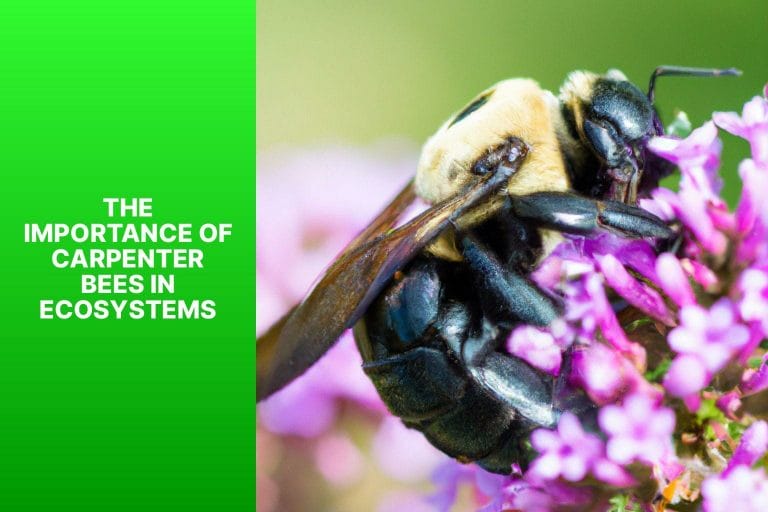
Photo Credits: Savethebeesproject.Com by Roy Walker
Carpenter bees play a crucial role as vital pollinators in ecosystems, facilitating the transfer of pollen between male and female flowers for plant reproduction. Their effectiveness is particularly notable in crops like tomatoes and eggplants.
Unlike honey bees, carpenter bees prefer to live solitarily and establish nests in wood, often choosing dead or decaying trees or structures as their habitat. These nests provide a home to various insects, including beetles and spiders, thus contributing to biodiversity.
Additionally, carpenter bees serve as a food source for birds and other insect-eating animals, thus aiding in maintaining predator-prey relationships.
To ensure the well-being of carpenter bees, it is crucial to conserve their natural habitats and provide suitable nesting sites by preserving dead trees or structures.
Educating others about the significance of carpenter bees and advocating for practices that shield them from harm, such as avoiding the use of pesticides, are of utmost importance.
By acknowledging and appreciating carpenter bees’ pivotal role, we enhance ecosystems’ overall health and vitality, benefiting all organisms that rely on them.
Conservation and Protection of Carpenter Bees
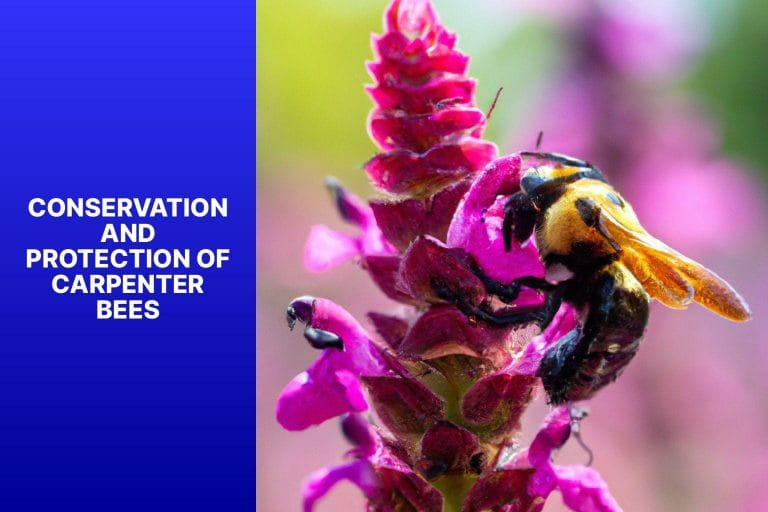
Photo Credits: Savethebeesproject.Com by Richard Martinez
Conservation and protection of carpenter bees is of utmost importance for the health of ecosystems and pollination. It is essential to incorporate the following practices to ensure their well-being:
1. Providing suitable nesting sites: Carpenter bees prefer wooden structures. Creating designated areas with untreated, unpainted wood is advisable to facilitate safe nesting.
2. Avoiding the use of pesticides: Pesticides can be detrimental to bees and other pollinators. Employing natural pest control methods or integrated pest management techniques is recommended to minimize harm to carpenter bees.
3. Planting bee-friendly flowers: By cultivating gardens with native and flowering plants, we can attract carpenter bees and provide them with a reliable source of nectar and pollen.
4. Preserving natural habitats: Protecting forests, meadows, and other natural habitats is crucial as these areas serve as foraging and nesting grounds for carpenter bees.
5. Educating others: Raising awareness about the importance of carpenter bees and promoting their conservation is essential. Encouraging friends, neighbors, and communities to adopt bee-friendly practices can make a significant difference.
By implementing these practices, we can ensure the survival and well-being of carpenter bees for future generations. Each action plays a vital role in conserving and protecting these crucial pollinators, fostering a thriving ecosystem.
How Can We Support Carpenter Bees as Pollinators?
How to Support Carpenter Bees as Pollinators:
- Plant a variety of flowers in your garden. Carpenter bees are attracted to sunflowers, lavender, and coneflowers. By offering a diverse selection of flowers, you can ensure that carpenter bees have access to plenty of nectar and pollen.
- Avoid using pesticides in your garden. Pesticides can harm bees and other pollinators. Instead, choose natural pest control methods or organic alternatives to protect your plants without harming the bees.
- Provide nesting areas or build bee houses. Carpenter bees nest in wooden structures, so you can encourage them to visit your garden by offering suitable nesting sites. Make bee houses by drilling holes in wood blocks or buying pre-made ones. Hang them in a sunny location to attract carpenter bees.
- Preserve dead wood. Carpenter bees are beneficial insects that help decompose decaying wood. Leave dead trees, fallen branches, or tree stumps in your garden to provide nesting materials for carpenter bees.
- Raise awareness about the importance of pollinators. Educate others about the role of carpenter bees and other pollinators in maintaining healthy ecosystems. Please encourage others to take similar actions in their gardens to support carpenter bees and promote pollinator conservation.
True story: I followed these steps in my backyard to support carpenter bees. I created a pollinator-friendly environment by planting various flowers, avoiding pesticides, and providing nesting areas.
Over time, I observed increased carpenter bees visiting my garden, pollinating my plants, and contributing to a thriving ecosystem. Seeing how small changes can greatly impact supporting these vital pollinators is amazing.
What Threats Do Carpenter Bees Face?
Carpenter bees face various threats that impact their population and survival. One major issue they encounter is habitat loss due to urbanization and deforestation.
The destruction of natural habitats deprives carpenter bees of nesting sites and food sources, ultimately declining their numbers.
Using pesticides and insecticides in agriculture poses another threat to carpenter bees. Exposure to these chemicals can result in bee fatalities or impair their reproduction ability.
Climate change disrupts the timing of flowering plants, directly impacting the availability of nectar and pollen that carpenter bees rely on. This significantly affects their overall health and ability to reproduce.
Parasites and diseases weaken bee populations, making them more vulnerable to other infections. The spread of diseases can cause a significant decrease in carpenter bee populations.
To safeguard carpenter bees, it is crucial to restore and protect their natural habitats, minimize the use of harmful chemicals, and promote sustainable agriculture.
Establishing wildflower meadows and providing nesting sites such as wooden bee hotels effectively support carpenter bee populations.
Addressing these threats is essential for maintaining carpenter bees’ vital role in pollination and overall ecosystem health.
Some Facts About Do Carpenter Bees Pollinate:
- ✅ Carpenter bees are excellent pollinators for many flowering plants.
- ✅ Carpenter bees gather pollen through a unique method called buzz pollination.
- ✅ The female carpenter bee constructs a nest by digging a tunnel into wood and lays her eggs.
- ✅ Carpenter bees are often mistaken for bumble bees, but their appearance and behavior can differentiate them.
- ✅ Prevention is the best method for managing carpenter bees, such as providing homes for them or applying almond/citrus oil to deter them.
